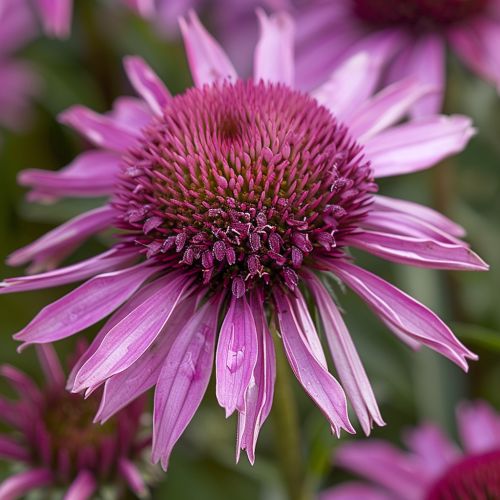Echinacea
Introduction
Echinacea is a genus of herbaceous flowering plants in the daisy family, Asteraceae. Commonly known as coneflowers, these plants are native to North America and are widely cultivated for their purported medicinal properties. Echinacea species are characterized by their large, showy flowers and spiny central disk, which gives them their name (from the Greek word "ekhinos," meaning hedgehog). This article delves into the botany, pharmacology, clinical applications, and cultivation of Echinacea, providing a comprehensive overview for those interested in this versatile genus.
Botany
Taxonomy and Species
Echinacea belongs to the tribe Heliantheae within the family Asteraceae. The genus comprises nine species, including:
- Echinacea purpurea (Purple Coneflower)
- Echinacea angustifolia (Narrow-leaved Coneflower)
- Echinacea pallida (Pale Purple Coneflower)
- Echinacea paradoxa (Yellow Coneflower)
- Echinacea simulata (Wavyleaf Purple Coneflower)
- Echinacea tennesseensis (Tennessee Coneflower)
- Echinacea atrorubens (Topeka Purple Coneflower)
- Echinacea laevigata (Smooth Coneflower)
- Echinacea sanguinea (Sanguine Purple Coneflower)
Each species exhibits unique morphological characteristics, but all share the distinctive conical flower head.
Morphology
Echinacea plants typically grow to a height of 1-4 feet, with a spread of 1-2 feet. The leaves are generally lanceolate to ovate, with a rough texture. The flowers, which bloom from late spring to early autumn, feature a prominent central cone surrounded by ray florets. The central cone is composed of numerous small disk florets, which are often spiny and can range in color from orange to brown.


Pharmacology
Active Constituents
Echinacea contains a variety of bioactive compounds, including:
- Alkylamides
- Polysaccharides
- Glycoproteins
- Caffeic acid derivatives (e.g., echinacoside, chicoric acid)
- Flavonoids
These constituents are believed to contribute to the plant's immunomodulatory and anti-inflammatory properties.
Mechanism of Action
The pharmacological effects of Echinacea are primarily attributed to its ability to modulate the immune system. Alkylamides, for instance, interact with cannabinoid receptors, influencing cytokine production and leukocyte activity. Polysaccharides and glycoproteins are thought to enhance phagocytosis and stimulate the release of tumor necrosis factor (TNF) and interleukins. Caffeic acid derivatives exhibit antioxidant properties, which may further support immune function.
Clinical Applications
Immunostimulant
Echinacea is widely used as an immunostimulant, particularly for the prevention and treatment of upper respiratory tract infections (URTIs). Several clinical trials have investigated its efficacy in reducing the incidence and duration of the common cold. While results are mixed, some studies suggest that Echinacea preparations can modestly reduce the risk of developing colds and shorten their duration.
Anti-inflammatory and Antioxidant Effects
In addition to its immunostimulant properties, Echinacea exhibits anti-inflammatory and antioxidant effects. These properties have been explored in the context of various inflammatory conditions, including arthritis and inflammatory bowel disease. The plant's ability to scavenge free radicals and inhibit pro-inflammatory cytokines makes it a potential therapeutic agent for managing oxidative stress and inflammation.
Other Potential Uses
Research is ongoing to explore other potential applications of Echinacea, including its use in cancer therapy, wound healing, and as an adjunct treatment for anxiety and depression. However, more rigorous clinical trials are needed to substantiate these claims.
Cultivation
Soil and Climate Requirements
Echinacea thrives in well-drained soils with a pH range of 6.0 to 7.0. The plants prefer full sun but can tolerate partial shade. They are hardy in USDA zones 3-9 and are relatively drought-tolerant once established.
Propagation
Echinacea can be propagated through seeds, division, or root cuttings. Seed propagation is the most common method and should be done in the spring or fall. Stratification, or cold treatment, of seeds for 30-90 days can improve germination rates. Division of mature plants is best done in the spring, while root cuttings can be taken in late autumn.
Pests and Diseases
Echinacea is generally resistant to pests and diseases, but it can be susceptible to Aster yellows, powdery mildew, and root rot. Regular monitoring and proper cultural practices, such as adequate spacing and watering, can help mitigate these issues.
